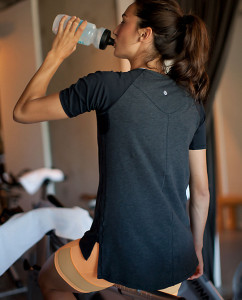Health professionals are split as to whether cooling down after exercise is important or provides any significant benefits. Some fitness professionals believe gradually decreasing the pace of your movements during the last five minutes of a workout is important because it gradually reduces your heart rate, helps your circulatory system remove some blood and anabolic waste from your muscles before you stretch and helps decrease stiffness and soreness after workouts. Additonally, after very intense exercise, stopping on a dime might cause cardio distress in very fit people who have reached and sustained high heart levels, or those with heart problems.
You might find that reducing your body temperature gradually before you head to the showers or your car might make you feel better. Other experts believe that a cooldown, such as decresing your speed on a treadmill by .5 mph each minute until you get to 1 mph, does not reduce instances of the Delayed Onset of Muscle Soreness, or DOMS.
Warmup
A warmup helps you coordinate your body’s function so that your heart, lungs and other muscles can begin working in unison from the start of your workout. A good warmup consists of dynamic movements, such as jumping jacks, arm swings or jogging in place, performed at a moderate intensity. This will help you gradually stretch your muscles, raise your body temperature and elevate your heart rate.
The Effects of Exercise
When you exercise, you shorten your muscles, raise your body temperature, elevate your heart rate and create lactic acid, adrenaline and other anabolic waste in your muscles. Blood also pools in your muscles, leading to DOMS.
Cooldown Benefits
When you exercise, your heart rate rises and you begin pumping blood faster throughout yoru body. If you stop your workouts withhout slowing down, you don’t give your heart and blood vessels a chance to gradually decrease the flow of blood to your muscles. Blood can pool there if you don’t cool down, so ending workouts without a cooldown and heading to the shower or getting into an air-conditioned car, might result in stiff, sore muscles for the rest of the day and when you wake up the next morning.
If you skip stretching, which some consider part of a cooldown, you might experience tighter muscles, especially in your calves and hamstrings, during subsequent activities. This can lead to tears or strains when you run, jump or perform other intense movements. After your cooldown, a good stretch helps get more blood and lactic acid out of your muscles and promotes flexibility—but static stretching is best left for post-workout recovery because it temporarily causes a decrease in power and jumping ability. This is an important aspect of a post-workout routine, since you don’t get to static stretch before a workout or sports if you want peak performance. Read our article on myth of stretching to find out why.
Cooldown Routine
An effective cooldown routine decreases your intensity level over the course of several minutes. On a treadmill, for example, you will reduce your speed by .5 mph every minute until you get to a slow walk, your breathing is near normal and your heart rate is below 100 beats per minutes. If you’ve just been lifting weights, you can walk around the gym, raising and lowering your arms. After an intense swim, walk slowly back and forth across the shallow end. When your have lowered your metabolism, perform a stretch of your muscles. Move your muscles to just beyond their comfortable range of motion, then hold for 20 to 30 seconds.
Bottom Line?
So many people swear by a cool down and post-workout stretch that it’s probably a very good idea to experiment with workouts that include cooling down and ones that skip the cooldown. Especially if you’re a trained athlete or have any heart problems, it can’t hurt to taper your intensity at the end of a workout instead of stopping cold.
Additional Resources
Brian Mac: Warm Up and Cool Down
The New York Times: Is the Exercise Cool-Down Really Necessary?
